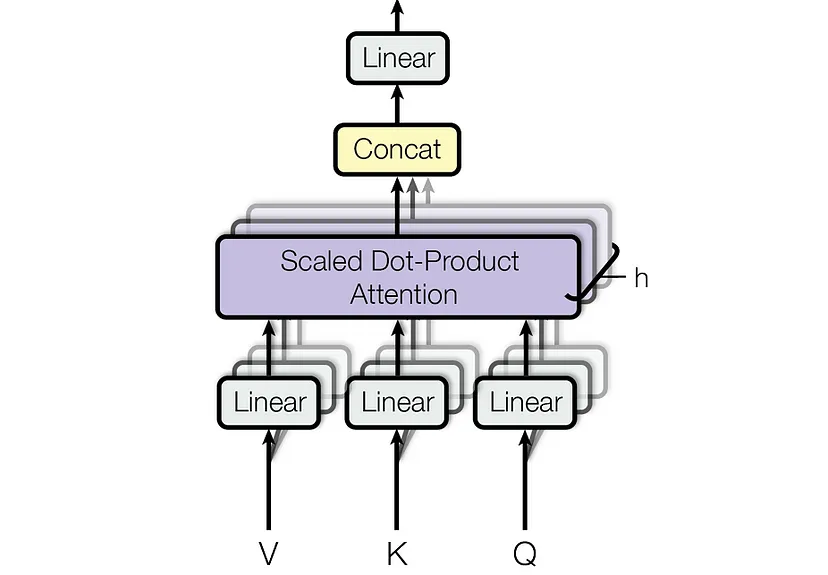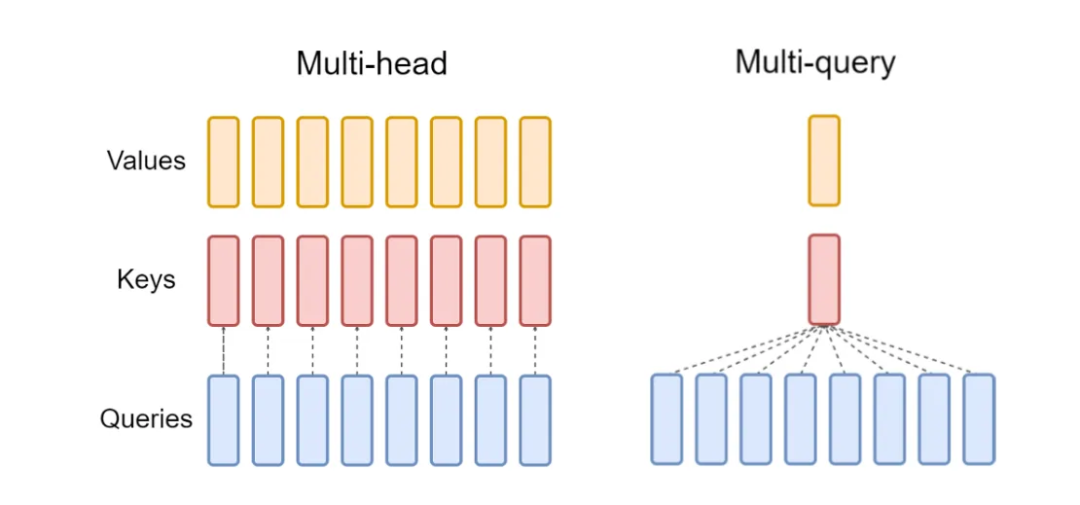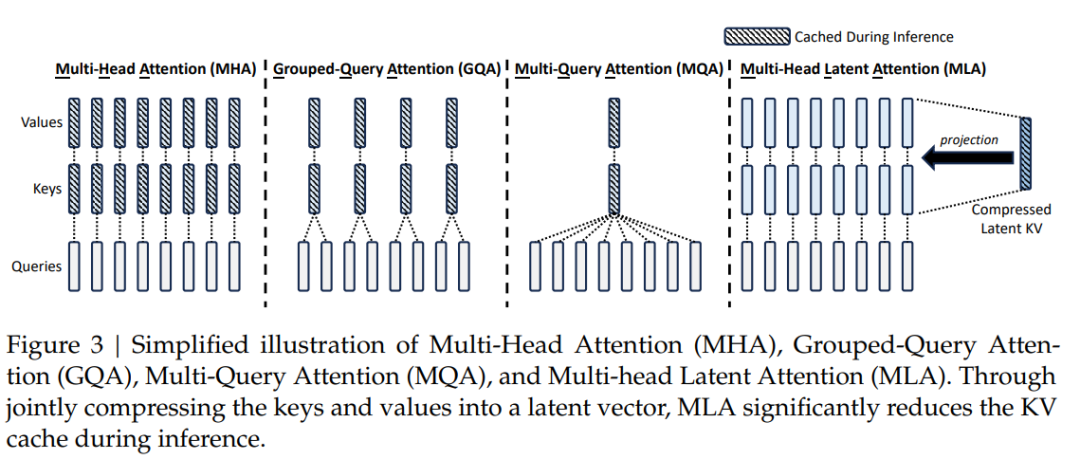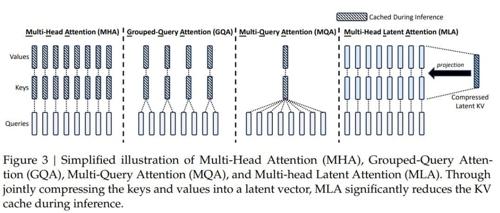Datawhale干货
作者:宋志学,Datawhale成员
Datawhale干货
作者:宋志学,Datawhale成员
作者|宋志学,编辑|SwanLab
多头注意力机制(Multi-Head Attention,MHA)
多头注意力(Multi-Head Attention, MHA)是Transformer模型的核心机制,通过并行计算多个注意力头,使模型能够同时关注输入序列中不同位置的特征。其核心思想是将输入映射到多个子空间,分别计算注意力权重并聚合结果,从而增强模型对复杂模式的捕捉能力。

第一阶段:线性变换与多头拆分
输入序列 (批大小 ,序列长度 ,特征维度 )通过可学习参数生成查询(Query)、键(Key)、值(Value):
随后,将 拆分为 个头,每个头的维度为 ,并调整形状为:
每个头独立计算注意力权重:
其中 表示查询与键的相似度矩阵,缩放因子 缓解点积过大导致的梯度消失。若存在掩码(如屏蔽填充位置),则对无效位置填充。
第三阶段:多头合并与输出投影
将所有头的输出拼接并映射回原始维度:
代码实现如下:
import torchimport torch.nn as nnclass MultiHeadAttention(nn.Module):def __init__(self, hidden_size, num_heads, dropout=0.0):"""多头注意力机制的实现。Args:hidden_size (int): 输入特征的维度,也即 hidden_state 的最后一维。num_heads (int): 注意力头的数量。dropout (float): dropout 的概率,默认为 0.0。"""super(MultiHeadAttention, self).__init__()assert hidden_size % num_heads == 0, "hidden_size 必须能被 num_heads 整除"self.hidden_size = hidden_sizeself.num_heads = num_headsself.head_dim = hidden_size // num_heads # 每个头的维度# 定义线性变换层,用于生成 Q, K, Vself.query = nn.Linear(hidden_size, hidden_size)self.key = nn.Linear(hidden_size, hidden_size)self.value = nn.Linear(hidden_size, hidden_size)self.dropout = nn.Dropout(dropout)# 输出线性层self.out_projection = nn.Linear(hidden_size, hidden_size)def forward(self, hidden_state, attention_mask=None):"""前向传播函数。Args:hidden_state (torch.Tensor): 输入的 hidden_state,形状为 [batch_size, seq_len, hidden_size]。attention_mask (torch.Tensor, optional): 注意力掩码,用于屏蔽某些位置,形状为 [batch_size, seq_len]。默认为 None。Returns:torch.Tensor: 注意力输出,形状为 [batch_size, seq_len, hidden_size]。"""batch_size, seq_len, _ = hidden_state.size()# 1. 通过线性层得到 Q, K, Vquery = self.query(hidden_state) # [batch_size, seq_len, hidden_size]key = self.key(hidden_state) # [batch_size, seq_len, hidden_size]value = self.value(hidden_state) # [batch_size, seq_len, hidden_size]# 2. 将 Q, K, V 拆分成多头query = query.view(batch_size, seq_len, self.num_heads, self.head_dim).transpose(1, 2) # [batch_size, num_heads, seq_len, head_dim]key = key.view(batch_size, seq_len, self.num_heads, self.head_dim).transpose(1, 2) # [batch_size, num_heads, seq_len, head_dim]value = value.view(batch_size, seq_len, self.num_heads, self.head_dim).transpose(1, 2) # [batch_size, num_heads, seq_len, head_dim]# 3. 计算注意力权重attention_weights = torch.matmul(query, key.transpose(-2, -1)) / (self.head_dim ** 0.5) # [batch_size, num_heads, seq_len, seq_len]# 应用 attention maskif attention_mask is not None:attention_weights = attention_weights.masked_fill(attention_mask[:, None, None, :] == 0, float('-inf'))attention_weights = torch.softmax(attention_weights, dim=-1) # [batch_size, num_heads, seq_len, seq_len]attention_weights = self.dropout(attention_weights)# 4. 计算上下文向量context = torch.matmul(attention_weights, value) # [batch_size, num_heads, seq_len, head_dim]# 5. 将多头合并context = context.transpose(1, 2).contiguous().view(batch_size, seq_len, self.hidden_size) # [batch_size, seq_len, hidden_size]# 6. 通过输出线性层output = self.out_projection(context) # [batch_size, seq_len, hidden_size]return outputif __name__ == '__main__':# 示例batch_size = 2seq_len = 10hidden_size = 256num_heads = 8# 创建一个 MHA 实例mha = MultiHeadAttention(hidden_size, num_heads)# 创建一个随机的 hidden_statehidden_state = torch.randn(batch_size, seq_len, hidden_size)# 创建一个 attention mask (可选)attention_mask = torch.ones(batch_size, seq_len)attention_mask[:, 5:] = 0 # 屏蔽掉每个 batch 中 seq_len 的后 5 个位置# 通过 MHA 层output = mha(hidden_state, attention_mask)# 打印输出形状print("输出形状:", output.shape) # torch.Size([2, 10, 256])
多查询注意力机制(Multi-Query Attention,MQA)
Multi-Query Attention (MQA) 是对多头注意力(MHA)的高效改进版本,其核心思想是共享键(Key)和值(Value)的投影参数,仅对查询(Query)使用独立的头参数。这种方法显著减少了模型参数量和计算复杂度,同时保留了多头注意力的部分并行性优势。

第一阶段:参数共享的线性变换
输入序列 通过以下线性变换生成 Query、共享的 Key 和 Value:
其中 是每个头独立的查询参数,而 是所有头共享的键和值参数()。与 MHA 不同,MQA 的 Key 和 Value 投影参数在头间共享,参数量减少 倍。
第二阶段:多头注意力计算
Query 被拆分为 个头(形状调整为 ),而 Key 和 Value 通过 unsqueeze 和 expand 扩展为 ,实现所有头共享相同的 Key/Value。注意力权重计算为:
其中 是第 个头的 Query,而 和 为共享的全局矩阵。此步骤保留了多头的并行性,但减少了 Key/Value 的冗余计算。
第三阶段:输出投影与优化
将所有头的输出拼接并通过输出投影层:
由于 Key/Value 共享,MQA 的总参数量为 ,远小于 MHA 的 (当 时)。这种设计在保持序列建模能力的同时,降低了显存占用和计算延迟,适合大规模模型部署。
代码实现如下:
import torchimport torch.nn as nnfrom thop import profileclass MultiQueryAttention(nn.Module):def __init__(self, hidden_size, num_heads, dropout=0.0):"""Multi-Query Attention 的实现。Args:hidden_size (int): 输入特征的维度,也即 hidden_state 的最后一维。num_heads (int): 注意力头的数量。dropout (float): dropout 的概率,默认为 0.0。"""super(MultiQueryAttention, self).__init__()assert hidden_size % num_heads == 0, "hidden_size 必须能被 num_heads 整除"self.hidden_size = hidden_sizeself.num_heads = num_headsself.head_dim = hidden_size // num_heads # 每个头的维度# 定义线性变换层,用于生成 Q, K, Vself.query = nn.Linear(hidden_size, hidden_size) # 每个头独立的 Queryself.key = nn.Linear(hidden_size, self.head_dim) # 所有头共享的 Keyself.value = nn.Linear(hidden_size, self.head_dim) # 所有头共享的 Valueself.dropout = nn.Dropout(dropout)self.out_projection = nn.Linear(hidden_size, hidden_size)def forward(self, hidden_state, attention_mask=None):"""前向传播函数。Args:hidden_state (torch.Tensor): 输入的 hidden_state,形状为 [batch_size, seq_len, hidden_size]。attention_mask (torch.Tensor, optional): 注意力掩码,用于屏蔽某些位置,形状为 [batch_size, seq_len]。默认为 None。Returns:torch.Tensor: 注意力输出,形状为 [batch_size, seq_len, hidden_size]。"""batch_size, seq_len, _ = hidden_state.size()# 1. 通过线性层得到 Q, K, Vquery = self.query(hidden_state) # [batch_size, seq_len, hidden_size]key = self.key(hidden_state) # [batch_size, seq_len, head_dim]value = self.value(hidden_state) # [batch_size, seq_len, head_dim]# 2. 将 Q 拆分为多头query = query.view(batch_size, seq_len, self.num_heads, self.head_dim).transpose(1, 2) # [batch_size, num_heads, seq_len, head_dim]# 3. 扩展 K 和 V 到 num_heads 维度(所有头共享相同的 K/V)key = key.unsqueeze(1).expand(-1, self.num_heads, -1, -1) # [batch_size, num_heads, seq_len, head_dim]value = value.unsqueeze(1).expand(-1, self.num_heads, -1, -1) # [batch_size, num_heads, seq_len, head_dim]# 4. 计算注意力权重attention_weights = torch.matmul(query, key.transpose(-2, -1)) / (self.head_dim ** 0.5) # [batch_size, num_heads, seq_len, seq_len]# 应用 attention maskif attention_mask is not None:attention_weights = attention_weights.masked_fill(attention_mask[:, None, None, :] == 0, float('-inf'))attention_weights = torch.softmax(attention_weights, dim=-1) # [batch_size, num_heads, seq_len, seq_len]attention_weights = self.dropout(attention_weights)# 5. 计算上下文向量context = torch.matmul(attention_weights, value) # [batch_size, num_heads, seq_len, head_dim]# 6. 将多头合并context = context.transpose(1, 2).contiguous().view(batch_size, seq_len, self.hidden_size) # [batch_size, seq_len, hidden_size]# 7. 通过输出线性层output = self.out_projection(context) # [batch_size, seq_len, hidden_size]return outputif __name__ == '__main__':# 示例batch_size = 2seq_len = 10hidden_size = 256num_heads = 8# 创建一个 MQA 实例mqa = MultiQueryAttention(hidden_size, num_heads)# 创建一个随机的 hidden_statehidden_state = torch.randn(batch_size, seq_len, hidden_size)# 创建一个 attention mask (可选)attention_mask = torch.ones(batch_size, seq_len)attention_mask[:, 5:] = 0 # 屏蔽掉每个 batch 中 seq_len 的后 5 个位置# 通过 MQA 层output = mqa(hidden_state, attention_mask)# 打印输出形状print("输出形状:", output.shape) # torch.Size([2, 10, 256])
分组查询注意力机制(Grouped Query Attention,GQA)
Grouped Query Attention (GQA) 是对多头注意力(MHA)和多查询注意力(MQA)的折中优化方案。其核心思想是将查询头(Query Heads)划分为多个组(Group),每组内的查询头共享一组键(Key)和值(Value),从而在保留多头并行性的同时减少参数量和计算复杂度。GQA 在参数效率与模型性能之间取得了平衡,适用于大规模模型的高效部署。

输入序列 (批大小 ,序列长度 ,特征维度 )通过以下线性变换生成 Query、分组共享的 Key 和 Value:
其中 是每个查询头独立的参数, 为组数( 为总头数, 为每组头数), 为每个头的维度。Key 和 Value 的投影参数按组划分,每组参数共享。
第二阶段:分组注意力计算
Query 被拆分为 个头(形状调整为 ),而 Key 和 Value 被拆分为 组(每组包含 个头共享的 Key/Value)。通过 unsqueeze 和 expand 操作,将每组 Key/Value 扩展到 个头,形成 的结构。注意力权重计算为:
其中 是第 个查询头, 和 是其所属组 的共享键和值。此设计使同一组内的查询头关注相同子空间,而不同组可学习不同的特征模式。
第三阶段:输出投影与参数优化
将所有头的输出拼接并通过输出投影层:
由于每组 Key/Value 被 个头共享,GQA 的总参数量为 ,显著低于 MHA 的 (当 时)。这种设计在保持多头多样性的前提下,减少了显存占用和计算延迟,适合长序列建模和大规模模型部署。
代码实现如下:
import torchimport torch.nn as nnclass GroupedQueryAttention(nn.Module):def __init__(self, hidden_size, num_heads, group_size=2, dropout=0.0):"""Grouped Query Attention 实现。Args:hidden_size (int): 输入特征的维度。num_heads (int): 查询头的数量。group_size (int): 每个组中包含的查询头数量。dropout (float): dropout 的概率。"""super(GroupedQueryAttention, self).__init__()assert hidden_size % num_heads == 0, "hidden_size 必须能被 num_heads 整除"assert num_heads % group_size == 0, "num_heads 必须能被 group_size 整除"self.hidden_size = hidden_sizeself.num_heads = num_headsself.group_size = group_sizeself.group_num = num_heads // group_sizeself.head_dim = hidden_size // num_heads# 查询头self.query = nn.Linear(hidden_size, hidden_size)# 键和值头(分组共享)self.key = nn.Linear(hidden_size, self.group_num * self.head_dim)self.value = nn.Linear(hidden_size, self.group_num * self.head_dim)self.dropout = nn.Dropout(dropout)self.out_projection = nn.Linear(hidden_size, hidden_size)def forward(self, hidden_state, attention_mask=None):"""前向传播函数。Args:hidden_state (torch.Tensor): 输入张量,形状为 [batch_size, seq_len, hidden_size]。attention_mask (torch.Tensor, optional): 注意力掩码,形状为 [batch_size, seq_len]。Returns:torch.Tensor: 注意力输出,形状为 [batch_size, seq_len, hidden_size]。"""batch_size, seq_len, _ = hidden_state.size()# 1. 通过线性层生成 Q, K, Vquery = self.query(hidden_state) # [batch_size, seq_len, hidden_size]key = self.key(hidden_state) # [batch_size, seq_len, group_num * head_dim]value = self.value(hidden_state) # [batch_size, seq_len, group_num * head_dim]# 2. 将 Q, K, V 拆分成多头query = query.view(batch_size, seq_len, self.num_heads, self.head_dim).transpose(1, 2) # [batch_size, num_heads, seq_len, head_dim]# K 和 V 扩展到 num_heads 个头key = key.view(batch_size, seq_len, self.group_num, self.head_dim).transpose(1, 2) # [batch_size, group_num, seq_len, head_dim]key = key.unsqueeze(2).expand(-1, -1, self.group_size, -1, -1).contiguous().view(batch_size, -1, seq_len, self.head_dim) # [batch_size, num_heads, seq_len, head_dim]value = value.view(batch_size, seq_len, self.group_num, self.head_dim).transpose(1, 2) # [batch_size, group_num, seq_len, head_dim]value = value.unsqueeze(2).expand(-1, -1, self.group_size, -1, -1).contiguous().view(batch_size, -1, seq_len, self.head_dim) # [batch_size, num_heads, seq_len, head_dim]# 3. 计算注意力权重attention_weights = torch.matmul(query, key.transpose(-2, -1)) / (self.head_dim ** 0.5)if attention_mask is not None:attention_weights = attention_weights.masked_fill(attention_mask[:, None, None, :] == 0, float('-inf'))attention_weights = torch.softmax(attention_weights, dim=-1)attention_weights = self.dropout(attention_weights)# 4. 计算上下文向量context = torch.matmul(attention_weights, value)# 5. 合并多头context = context.transpose(1, 2).contiguous().view(batch_size, seq_len, self.hidden_size)# 6. 输出投影output = self.out_projection(context)return output# 示例if __name__ == '__main__':batch_size = 2seq_len = 10hidden_size = 256num_heads = 8group_size = 2 # 每组 2 个头,共 4 组gqa = GroupedQueryAttention(hidden_size, num_heads, group_size)hidden_state = torch.randn(batch_size, seq_len, hidden_size)attention_mask = torch.ones(batch_size, seq_len)attention_mask[:, 5:] = 0 # 屏蔽后 5 个位置output = gqa(hidden_state, attention_mask)print("输出形状:", output.shape) # torch.Size([2, 10, 256])
多头潜在注意力(Multi-Head Latent Attention, MLA)
Multi-Head Latent Attention (MLA) 是一种结合低秩参数化与旋转位置编码(RoPE)的高效注意力机制。其核心思想是通过低秩投影压缩查询(Q)、键(K)、值(V)的维度,并在注意力计算中解耦内容与位置信息,从而减少计算复杂度,同时保留长距离依赖建模能力。MLA 特别适用于大规模模型的部署,平衡了效率与性能。

第一阶段:低秩参数化与投影
输入序列 (批大小 ,序列长度 ,特征维度 )通过低秩投影层生成压缩的潜变量:
其中 为降维后的维度(down_dim)。随后,通过升维投影生成 Q/K/V:
此处 为升维后的维度(up_dim),低秩参数化显著减少了线性层的参数量(代码中通过 down_proj 和 up_proj 实现)。
第二阶段:解耦的内容与位置编码
MLA 将内容信息与位置信息分离处理:
-
内容分支:Q/K/V 的升维结果按头数 拆分为多头:
-
位置分支:通过 RoPE 编码增强位置感知能力:
其中 为 RoPE 的头维度(rope_head_dim),并通过 expand 操作共享至所有头(代码中通过 proj_qr 和 proj_kr 实现)。最终 Q/K 为内容与位置分支的拼接:
第三阶段:多头注意力与输出
计算注意力权重并融合内容与位置信息:
其中 直接由升维后的 生成并拆分为多头(代码中通过 v_head_dim 控制维度)。最终输出为:
MLA 的总参数量为 ,远低于传统 MHA 的 (当 时)。这种设计在保留多头多样性的前提下,显著降低了显存与计算开销。
import torchimport torch.nn as nnimport mathclass RotaryEmbedding(nn.Module):def __init__(self, hidden_size, num_heads, base=10000, max_len=512):"""RoPE位置编码模块Args:hidden_size (int): 模型维度num_heads (int): 注意力头数量base (int): 频率基值max_len (int): 最大序列长度"""super().__init__()self.head_dim = hidden_size // num_headsself.hidden_size = hidden_sizeself.num_heads = num_headsself.base = baseself.max_len = max_lenself.cos_pos_cache, self.sin_pos_cache = self._compute_pos_emb()def _compute_pos_emb(self):theta_i = 1. / (self.base ** (torch.arange(0, self.head_dim, 2).float() / self.head_dim))positions = torch.arange(self.max_len)pos_emb = positions.unsqueeze(1) * theta_i.unsqueeze(0)cos_pos = pos_emb.sin().repeat_interleave(2, dim=-1)sin_pos = pos_emb.cos().repeat_interleave(2, dim=-1)return cos_pos, sin_posdef forward(self, q):"""RoPE位置编码应用Args:q (torch.Tensor): 输入张量 [bs, num_heads, seq_len, head_dim]Returns:torch.Tensor: 应用位置编码后的张量"""bs, seq_len = q.shape[0], q.shape[2]cos_pos = self.cos_pos_cache[:seq_len].to(q.device) # [seq_len, head_dim]sin_pos = self.sin_pos_cache[:seq_len].to(q.device) # [seq_len, head_dim]# 扩展维度以匹配batch和head维度cos_pos = cos_pos.unsqueeze(0).unsqueeze(0) # [1, 1, seq_len, head_dim]sin_pos = sin_pos.unsqueeze(0).unsqueeze(0) # [1, 1, seq_len, head_dim]# RoPE变换q2 = torch.stack([-q[..., 1::2], q[..., ::2]], dim=-1) # 奇偶交替q2 = q2.reshape(q.shape).contiguous()return q * cos_pos + q2 * sin_posclass MultiHeadLatentAttention(nn.Module):def __init__(self, hidden_size=256, down_dim=64, up_dim=128, num_heads=8, rope_head_dim=26, dropout_prob=0.0):"""Multi-Head Latent Attention 实现Args:hidden_size (int): 输入特征维度down_dim (int): 降维后的维度up_dim (int): 升维后的维度num_heads (int): 注意力头数量rope_head_dim (int): RoPE编码的头维度dropout_prob (float): Dropout概率"""super(MultiHeadLatentAttention, self).__init__()self.d_model = hidden_sizeself.down_dim = down_dimself.up_dim = up_dimself.num_heads = num_headsself.head_dim = hidden_size // num_headsself.rope_head_dim = rope_head_dimself.v_head_dim = up_dim // num_heads# 降维投影self.down_proj_kv = nn.Linear(hidden_size, down_dim)self.down_proj_q = nn.Linear(hidden_size, down_dim)# 升维投影self.up_proj_k = nn.Linear(down_dim, up_dim)self.up_proj_v = nn.Linear(down_dim, up_dim)self.up_proj_q = nn.Linear(down_dim, up_dim)# 解耦Q/K投影self.proj_qr = nn.Linear(down_dim, rope_head_dim * num_heads)self.proj_kr = nn.Linear(hidden_size, rope_head_dim)# RoPE位置编码self.rope_q = RotaryEmbedding(rope_head_dim * num_heads, num_heads)self.rope_k = RotaryEmbedding(rope_head_dim, 1)# 输出层self.dropout = nn.Dropout(dropout_prob)self.fc = nn.Linear(num_heads * self.v_head_dim, hidden_size)self.res_dropout = nn.Dropout(dropout_prob)def forward(self, h, mask=None):"""前向传播Args:h (torch.Tensor): 输入张量 [bs, seq_len, d_model]mask (torch.Tensor): 注意力掩码 [bs, seq_len]Returns:torch.Tensor: 输出张量 [bs, seq_len, d_model]"""bs, seq_len, _ = h.size()# Step 1: 低秩转换c_t_kv = self.down_proj_kv(h) # [bs, seq_len, down_dim]k_t_c = self.up_proj_k(c_t_kv) # [bs, seq_len, up_dim]v_t_c = self.up_proj_v(c_t_kv) # [bs, seq_len, up_dim]c_t_q = self.down_proj_q(h) # [bs, seq_len, down_dim]q_t_c = self.up_proj_q(c_t_q) # [bs, seq_len, up_dim]# Step 2: 解耦Q/K处理# RoPE投影处理q_t_r = self.proj_qr(c_t_q) # [bs, seq_len, rope_head_dim*num_heads]q_t_r = q_t_r.view(bs, seq_len, self.num_heads, self.rope_head_dim).transpose(1, 2) # [bs, num_heads, seq_len, rope_head_dim]q_t_r = self.rope_q(q_t_r) # 应用RoPE编码k_t_r = self.proj_kr(h) # [bs, seq_len, rope_head_dim]k_t_r = k_t_r.unsqueeze(1) # [bs, 1, seq_len, rope_head_dim]k_t_r = self.rope_k(k_t_r) # 应用RoPE编码# Step 3: 注意力计算# Q/K/V维度调整q_t_c = q_t_c.view(bs, seq_len, self.num_heads, -1).transpose(1, 2) # [bs, num_heads, seq_len, up_dim/num_heads]q = torch.cat([q_t_c, q_t_r], dim=-1) # [bs, num_heads, seq_len, (up_dim+rope_head_dim)/num_heads]k_t_c = k_t_c.view(bs, seq_len, self.num_heads, -1).transpose(1, 2) # [bs, num_heads, seq_len, up_dim/num_heads]k_t_r = k_t_r.expand(bs, self.num_heads, seq_len, -1) # [bs, num_heads, seq_len, rope_head_dim]k = torch.cat([k_t_c, k_t_r], dim=-1) # [bs, num_heads, seq_len, (up_dim+rope_head_dim)/num_heads]# 计算注意力权重scores = torch.matmul(q, k.transpose(-1, -2)) # [bs, num_heads, seq_len, seq_len]scores = scores / (math.sqrt(self.head_dim) + math.sqrt(self.rope_head_dim))if mask is not None:scores = scores.masked_fill(mask[:, None, None, :] == 0, float('-inf')) # [bs, num_heads, seq_len, seq_len]attn_weights = torch.softmax(scores, dim=-1) # [bs, num_heads, seq_len, seq_len]attn_weights = self.dropout(attn_weights)# V维度调整v_t_c = v_t_c.view(bs, seq_len, self.num_heads, self.v_head_dim).transpose(1, 2) # [bs, num_heads, seq_len, v_head_dim]# 计算上下文向量context = torch.matmul(attn_weights, v_t_c) # [bs, num_heads, seq_len, v_head_dim]# 合并多头context = context.transpose(1, 2).contiguous().view(bs, seq_len, -1) # [bs, seq_len, num_heads*v_head_dim]# 输出投影output = self.fc(context) # [bs, seq_len, d_model]output = self.res_dropout(output)return outputif __name__ == '__main__':batch_size = 2seq_len = 10hidden_size = 256h = torch.randn(batch_size, seq_len, hidden_size)mla = MultiHeadLatentAttention(hidden_size=hidden_size)# 创建可选掩码mask = torch.ones(batch_size, seq_len)mask[:, 5:] = 0output = mla(h, mask)print("输出形状:", output.shape) # 应输出 torch.Size([2, 10, 256])
Attention 计算复杂度
所有 Attention 的参数为:batch_size = 2, seq_len = 10, hidden_size = 256, num_heads = 8
========== Attention Test ==========MHA Output Shape: torch.Size([2, 10, 256])MHA Params: 263168, FLOPs: 2621440.0=======================================MQA Output Shape: torch.Size([2, 10, 256])MQA Params: 148032, FLOPs: 1474560.0=======================================GQA Output Shape: torch.Size([2, 10, 256])GQA Params: 197376, FLOPs: 1966080.0=======================================MLA Output Shape: torch.Size([2, 10, 256])MLA Params: 111082, FLOPs: 1100800.0
代码如下:
import torchfrom torch import nnfrom thop import profilefrom contextlib import redirect_stdoutfrom MHA import MultiHeadAttentionfrom MQA import MultiQueryAttentionfrom GQA import GroupedQueryAttentionfrom MLA import MultiHeadLatentAttentiondef count_params_and_flops(module: nn.Module, input_shape: tuple):"""统计指定模型模块的参数量和计算量(FLOPs)Args:module: PyTorch 模块对象input_shape: 输入张量的形状 (元组形式, 不包含 batch 维度)Returns:params_total: 总参数量flops_total: 总计算量"""# 构造示例输入dummy_input = torch.randn(1, *input_shape) # 添加 batch 维度# 计算参数量(单位:k)params_total = sum(p.numel() for p in module.parameters())# 计算计算量(单位:GFLOPs)with redirect_stdout(open("/dev/null", "w")): # 屏蔽 thop 日志flops_total, _ = profile(module, inputs=(dummy_input,))return params_total, flops_totalif __name__ == '__main__':# 示例batch_size = 2seq_len = 10hidden_size = 256num_heads = 8# 创建一个随机的 hidden_statehidden_state = torch.randn(batch_size, seq_len, hidden_size)# 创建一个 attention mask (可选)attention_mask = torch.ones(batch_size, seq_len)attention_mask[:, 5:] = 0 # 屏蔽掉每个 batch 中 seq_len 的后 5 个位置print("==" * 5, " Attention Test ", "==" * 5)# 创建一个 MHA 实例mha = MultiHeadAttention(hidden_size, num_heads)# 通过 MHA 层mha_output = mha(hidden_state, attention_mask)# 打印输出形状print("MHA Output Shape:", mha_output.shape)# 统计参数量和计算量mha_params, mha_flops = count_params_and_flops(mha, (seq_len, hidden_size))print(f"MHA Params: {mha_params}, FLOPs: {mha_flops}")print("===" * 13)# 创建一个 MQA 实例mqa = MultiQueryAttention(hidden_size, num_heads)# 通过 MQA 层mqa_output = mqa(hidden_state, attention_mask)# 打印输出形状print("MQA Output Shape:", mqa_output.shape)# 统计参数量和计算量mqa_params, mqa_flops = count_params_and_flops(mqa, (seq_len, hidden_size))print(f"MQA Params: {mqa_params}, FLOPs: {mqa_flops}")print("===" * 13)# 创建一个 GQA 实例group_size = 2 # 每组 2 个头,共 4 组gqa = GroupedQueryAttention(hidden_size, num_heads, group_size)# 通过 GQA 层gqa_output = gqa(hidden_state, attention_mask)# 打印输出形状print("GQA Output Shape:", gqa_output.shape)# 统计参数量和计算量gqa_params, gqa_flops = count_params_and_flops(gqa, (seq_len, hidden_size))print(f"GQA Params: {gqa_params}, FLOPs: {gqa_flops}")print("===" * 13)# 创建一个 MLA 实例mla = MultiHeadLatentAttention(hidden_size=hidden_size, num_heads=num_heads)# 通过 MLA 层mla_output = mla(hidden_state, attention_mask)# 打印输出形状print("MLA Output Shape:", mla_output.shape)# 统计参数量和计算量mla_params, mla_flops = count_params_and_flops(mla, (seq_len, hidden_size))print(f"MLA Params: {mla_params}, FLOPs: {mla_flops}")
参考引用
[1] 苏剑林. (2024, May). 缓存与效果的极限拉扯:从MHA、MQA、GQA到MLA.[Online]. :
https://kexue.fm/archives/10091
[2] 苏剑林. (2025, May). Transformer升级之路:20、MLA究竟好在哪里? [Online].:
https://kexue.fm/archives/10907
[3] 三重否定. 知乎文章 多头隐注意力(Multi-Head Latent Attention, MLA) 及简洁pytorch 实现:
https://zhuanlan.zhihu.com/p/715155329

一起“点赞”三连↓
(文:Datawhale)

